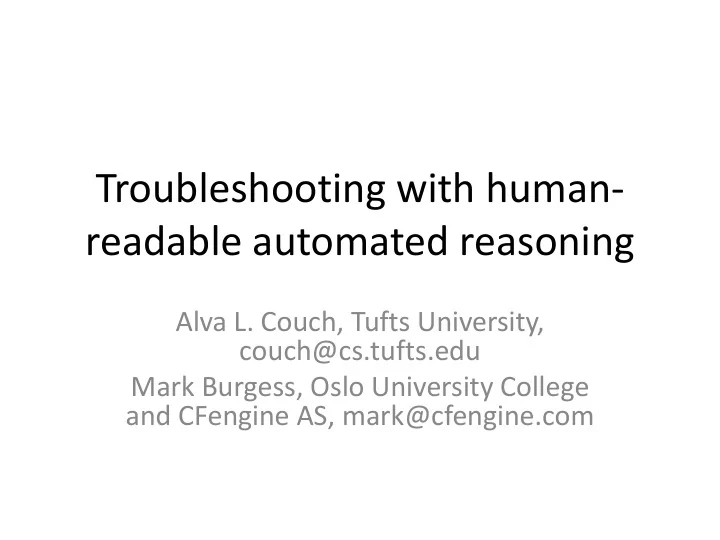

Troubleshooting with human- readable automated reasoning Alva L. Couch, Tufts University, couch@cs.tufts.edu Mark Burgess, Oslo University College and CFengine AS, mark@cfengine.com
Formal logic? How many of you have studied logic? … because I am going to do something very “illogical”. “Logic is a bouquet of pretty flowers, that smell bad.” - Leonard Nimoy, as Spock
What is this talk about? • How to troubleshoot systems based upon their architecture, • based upon a naïve logic of causal relationships between architectural entities, • that is optimized for readability by sysadmins, understandability, and efficient computation. • that describes which relationships might be present as a first-order approximation, like a “ bloom filter for logic”
Architecture and troubleshooting • Architecture defines connections between entities. • Troubleshooting requires understanding those connections. • We provide a way to: – recall connections relevant to a problem – make and explain new connections via a strange kind of logic.
Entities and relationships • Entity: something one manages, e.g., – Hosts – Services – Classes of hosts or services • Relationship: some constraint between entities – Causal: determines , influences – Dependence: provides , requires – Intent: promises , uses – Class: is an instance of , is a subclass of – Structural: is a part of , is a component of
Architectural facts host01 provides file service subject verb phrase object entity relationship entity • Notation host01|provides|file service
Inference rules Make new connections between entities. Change the level of abstraction of a fact. Three ways to infer relationships Implications: raise the level of abstraction Inverses: allow a fact to be “reversed” Connections: document indirect relationships
Implication If host01 provides file service, then host01 influences file service. provides : a concrete relationship influences : an abstract relationship motive: reason abstractly, report concretely. Notation: provides->influences
Inverses host01 provides file service whenever file service is provided by host01 This is just a matter of notation. It makes other rules easier to write down. Notation: provides<>is provided by
Connections If host03 is an instance of dns server, and a dns server is required by host07, then host03 might influence host07. host03 is an instance of dns server might influence is required by host07 Notation: is an instance of^is required by^might influence
Why this is strange • Most attempts at computer logic attempt to translate English into logic and then reason from that. • This method translates architectural information to simple English and then reasons from that, without translating the English into logic! • Main advantage is incredible speed!
Exterior semantics • Usually, one defines the meaning of English phrases in a dictionary . • In our system, one defines relationship meanings via their interaction with other relationships .
What does “influences” mean? determines->influences determines^determines^determines determines^influences^influences influences^determines^influences influences^influences^influences determines^has part^determines determines^is a part of^influences is an instance of^determines^determines has instance^determines^influences provides^is required by^might influence
Two claims of this paper • Claim 1: this logic is easy to describe and compute. • Claim 2: the results of inference are human- readable.
Demonstration: A really simple architecture Server1: web server/client Server1: web Client1 server/server Server3: files Client1 Server4: DHCP/LDAP
A naïve architectural description file server|provides|user file service file server|provides|web file service file server|requires|dns # assign roles to machines web server|provides|web service server1|is a|web server web server|requires|web file service server2|is a|web server web server|requires|dns server3|is a|file server server4|is a|network server network server|provides|dns client1|is a|workstation network server|provides|dhcp client2|is a|workstation workstation|requires|dns workstation|requires|dhcp workstation|requires|user file service workstation|requires|web service
What can cause problems with client1? Architectural facts: client1|requires|dhcp client1|requires|dns client1|requires|user file service client1|requires|web service Inferred facts: server1|might influence|client1 server2|might influence|client1 server3|might influence|client1 server4|might influence|client1
server1 might influence client1 server1 is an instance of web server provides provides web service might influence is required by workstation is required by has instance client1
We don’t need the details server1 • We can omit the logic. is an instance of web server • The flow speaks for itself. provides • By sticking to simple web service inference, we can is required by understand it without workstation explanation. has instance client1
A simple prototype • A Perl CGI script • All calculations online from text declarations. Configuring the prototype • Describe architecture • Reuse rules. Using the prototype • Choose a trouble-spot; connections are listed. • Click on a connection to explain it.
Critique +: uses simple sentences -: doesn’t handle complex sentences +: very fast -: doesn’t support complex logic +: very quick answer -: relatively naïve answer, the “shortest explanation” But a naïve answer is better than no answer at all!
Lessons learned • Causal connections are much more useful than unrestricted connections. • Readable logic is much more useful than highly accurate (and expensive) logic. • A weak logic can be a useful tool in troubleshooting.
Future work • Field testing. • Coding in Map/Reduce for at-scale calculations. • Using regular logic to verify discovered relationships. • Coupling with other information sources. • Apply this to other domains, e.g., documentation. • Build this algorithm into Cfengine Constellation.
Please • Play with the prototype: http://www.cs.tufts.edu/~couch/topics • Let us know – how it works for you – how it could be improved – what it should really do Alva L. Couch, couch@cs.tufts.edu Mark Burgess, mark@cfengine.com
Recommend
More recommend